#the ebers papyrus
Text
Damn. I was sober on tjmblr 2 hrs ago and now I'm drunk on tumblr and I just wanna reblog all my own previously 2 hrs ago reblogged tumblr posts
And now I'm gonna tag this with irrelevant shit bc idk how many tags are allowed to reach tag searches bc it was 5 before and now it's more than that
#jcbx#juices#rainbows#toads#toad#mario kart#pliny the elder#the ebers papyrus#sundew#антенну#i swiped to russian keyboard and idknwhat that means#yeehaw#boy howdy#gotta press play#megahertz
0 notes
Text
"Back in my day nobody had depression."
The term itself only came into use around the 19th century, however the symptoms of depression were seen on the Ebers Papyrus which dates around 1550 BCE. The descriptions include “His mind (ib) is shrouded in darkness, he (the man) tastes his heart (HAti). This means that his heart (ib) is narrowed and dark in his belly as a result of dmud; it causes fits of powerlessness.” (855w)
That is a translation of the original Egyptian text, which goes hand in hand with the modern descriptions of depression.
In other words, yes people had depression "back in your day."
#ebers papyrus#i had one lecture on this and I not refuse to let boomers and gen x forget it#“back in my day”#and this is only the first documented instance of depression#toonce offtopic
4 notes
·
View notes
Text

Abortion has historically and will always be a right for both women and people who menstruate, because while progress can be slowed down it can’t ever be stopped!
🩺❤️
#history#abortion#ancient egypt#human rights#medical practice#mummification#ancient history#kahun papyrus#medicine#medical history#abortion rights#abortion history#egyptology#people who menstruate#womens rights#egyptian culture#ebers papyrus#ancient medical practice#ancient world#ancient egyptian history#papyrus#healthcare#nickys facts
24 notes
·
View notes
Text

Incredible dental work found on a 4,000 year old mummy. Early origins of dentistry.
xxx






https://theafricanhistory.com/622
#Ancient Egypt#mummy#dentistry#teeth#Edwin Smith Papyrus#Ebers Papyrus#Hesi-Re#Pharaoh Djoser#Pharaonic physicians
1 note
·
View note
Note
Do you know how our understanding and treatment of diabetes has changed through history?
Oooh good question, anon!
As you may guess, diabetes mellitus is not new.

We've known about it since at least the Ebers Papyrus (1550 BCE) when the disease and a treatment was first described. This treatment was: "a liquid extract of bones, grain, grit, wheat, green lead and earth." I did not look these up, but I would guess they did not do a whole lot for the treatment of diabetes.
Later during the 6th century BCE it was first given a name when it was described by Hindu physician Sushruta as madhumeh or "honey urine."
Honey urine is a very apt descriptor for diabetes. In any type, one of the most measurable symptoms is that the person urinates a lot, and the urine tastes sweet (or, if one didn't feel like tasting, that it ferments, or that it attracts ants). This was also the first test for diabetes.
The reason for the sweetness of the urine (as well as a lot of other general info about diabetes) is spelled out more clearly in my "Don't Be That Guy Who Wrote Hansel and Gretel: Witch Hunters" post.
A Greek physician Apolonius of Memphis named it Diabetes, meaning "to siphon" (referring to the large amount of urine lost).
Roman physician Aretaeus later made the first precise description of diabetes. This included the classic symptoms of incessant thirst, copious urination, and constant hunger leading to emaciation and death. He also notes that if deprived of water, the patient will continue to urinate until they become so dehydrated that they die.
The term "Mellitus" was not added until the 1600s by an English physician Thomas Willis. This was again due to the sweetness of the expressed urine. Willis prescribed a diet of "slimy vegetables, rice, and white starch. He also suggested a milk drink which was distilled with cypress tops and egg whites, two powders (a mixture of gum arabic and gum dragant), rhubarb and cinnamon". Supposedly his patients improved if they kept to this diet, though few managed it long term. I honestly don't know how it would have worked, even temporarily.
A major breakthrough came in 1889 when it was discovered that if you removed the pancreas from a dog, the dog would become diabetic (particularly, that it would urinate large quantities of sweet urine). Up until this point it was thought that diabetes stemmed from the kidneys and bladder, or perhaps the lungs. This was the first time it had been shown experimentally that the pancreas was the problem.
Speaking of this, this was also part of a series of experiments where an English physician named Merkowski implanted a small amount of pancreas in the pancreas-less dog's fat, which reversed the diabetes temporarily. This proved that the pancreas was making something that helped regulate blood (and thus urine) sugar.
What this was wasn't figured out until 1921, when Canadian scientists Banting and Best (with help from McLeod and Collip) isolated something they called insletin (after the islets of langerhans, where the substance was being produced). It's important to note that all of these scientists hated each other so much they almost refused a Nobel Prize over it. Later, Collip would refine the substance and McLeod would rename it insulin.
Prior to insulin existing there was basically 1 vaguely useful treatment for diabetes. Unfortunately, that was starvation. So you could either die a slow and painful death by diabetes or you could die a slightly less slow but still painful death due to eating about 500 calories per day. Either way, diabetes was fatal, usually within a couple of years of diagnosis.
By 1923, the first commercial insulin product, Iletin, had been developed. Iletin was a U10 insulin (10 units per 1 milliliter- less potent than today's U100 and U500 insulins) and was made from pork pancreases. It took nearly a ton of pork pancreas to make 1oz of insulin. Fortunately, as a byproduct of the meat industry, pancreases were readily available.
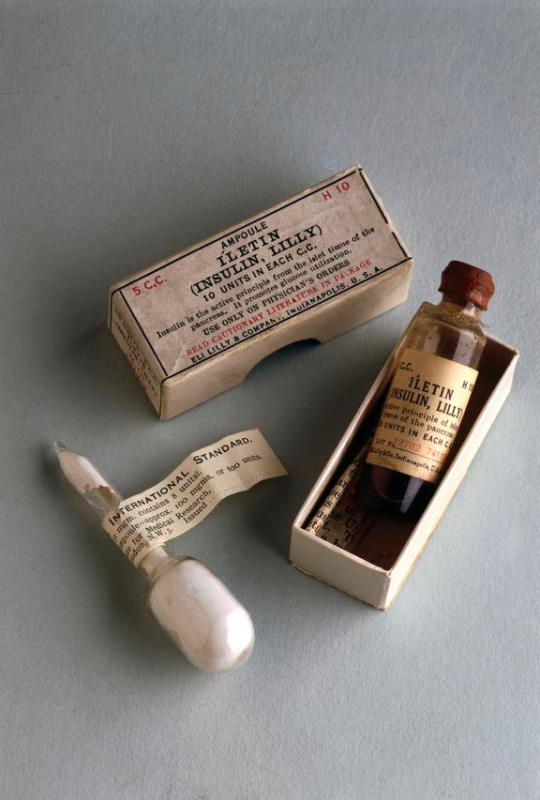
Now, you might be thinking- no one has mentioned type 1 or type 2 yet in this entire post!
Well, you would be right, because diabetes wouldn't be split into 2 forms (insulin-dependent and non-insulin dependent) until 1979, and wouldn't be classified as types 1 and 2 until 1995. That's right- some of you were alive when there was only one kind of diabetes out there.
Now, there's more about the types in the Hansel and Gretel post, but essentially type 1 diabetes occurs when the pancreas itself stops producing insulin, usually in childhood. When this happens, the body stops being able to use sugar (insulin, a hormone, acts as a "key" to let sugar into cells for use). Without replacing that insulin, the person dies because their cells starve.
Type 2 diabetes occurs when the pancreas still produces insulin, but the cells stop responding to it correctly. This causes high sugar levels in the blood, which causes longer-term complications (infections, ulcers, blindness, neuropathy, heart and kidney disease, hyperosmolar syndrome, etc..) which eventually lead to death.
We started discovering oral drugs that worked on what would later become type 2 in the 1950s. Particularly those that worked by increasing the insulin output of the pancreas, but only when the pancreas was still producing some insulin.
Predicting which diabetics would benefit from oral therapies was challenging, but it was recognized that when the onset of diabetes was slow and came on in adulthood, the oral agents would work, while if it came on suddenly in childhood, the oral agents wouldn't. Terms like "adult onset" and "maturity onset" were common:

(Side note: if you have ever read Alas, Babylon (1955) there is a diabetic character who by today's standards clearly has type 1 diabetes, but wants to switch to the "new oral pill" (called "orinase" in the book, though they are likely referring to diabinese pictured above).)
From 1923 into the 1980s, insulin was given once or twice per day, and not particularly titrated to blood sugar. This was probably just because we didn't have a great way to measure blood sugar in real time. Pre-1970s, there was no way to test blood sugar outside of a lab setting.

Urine testing was common starting in the 1940s, but was cumbersome as it required a flame for heating the urine. By the 1950s, a test had been developed that didn't require a flame, but was still not practical for home use. In the 1960s, paper strips were developed that changed color for different amounts of sugar in the urine. The problem with this was that the strips couldn't change color until there was sugar in the urine- a blood sugar level of over 200 by today's measurements. Low blood sugar readings were impossible at this time, and had to be treated based on symptoms.
In the 1970s, blood sugar could finally be measured by putting a drop of blood on a test strip, wiping it off, and matching the color of the test strip to a chart. While less cumbersome than urine tests, this was still something that would generally only be done at a doctor's office.

In 1983, the first home blood glucometer is developed. Finally, it was practical to take one's sugar multiple times per day, and it becomes possible to experiment with "sliding scale" insulin injections that keep tighter control of blood sugar. By the late 90s, continuous glucose monitors became available- though unlike today's CGMs that allow readings in real time on a smartphone or monitor, these had to be downloaded to a computer at regular intervals.
The 1980s were the first decade where insulin pumps become widely available. The very first pump was large and had to be carried in a backpack, but it represented a huge step forward in glucose control, as it more closely mimicked the function of a working pancreas than once-daily injections.
For the next 30 or so years you really had to work to qualify for an insulin pump, but recently it's been found that pumps greatly improve compliance with blood glucose control whether or not the person had good compliance before getting the pumps, and insurance has gotten better about covering them (though CGMs are still a pain to get insurance to cover).
The 1980s was also the decade that recombinant human insulin (insulin made by genetically modified bacteria) was first used. Up until that point the only insulins were pork and beef insulins, which some people had allergic reactions to. Recombinant insulin was closer to regular human insulin than beef or pork, and represented a big change in how insulin was made.
Today for people who take insulin to manage their diabetes, insulin is usually given as a single injection of a long-acting basal insulin, coupled with smaller doses of ultra-short-acting insulins with meals or snacks. This is the closest we've gotten to mimicking the way a pancreas would work in the wild, and keeps very tight control of blood sugar. This can be done by fingerstick blood sugar tests and individual injections of insulin, or it can be done with a CGM and pump- it just depends on the resources available to the person and their personal preference.
105 notes
·
View notes
Text

Ancient Egyptian hippo & hedgehog squad at the Brooklyn Museum!
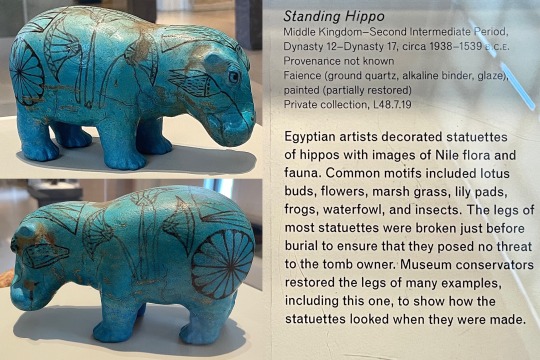
Standing Hippo
Middle Kingdom 2nd Int. Per. Dyn.12-17 c1938-1539BCE
Faience
“Egyptian artists decorated statuettes of hippos with images of Nile flora & fauna. Common motifs included lotus buds, flowers, marsh grass, lily pads, frogs, waterfowl, & insects. The legs of most statuettes were broken just before burial to ensure that they posed no threat to the tomb owner. Museum conservators restored the legs of many examples, including this one, to show how the statuettes looked when they were made.”
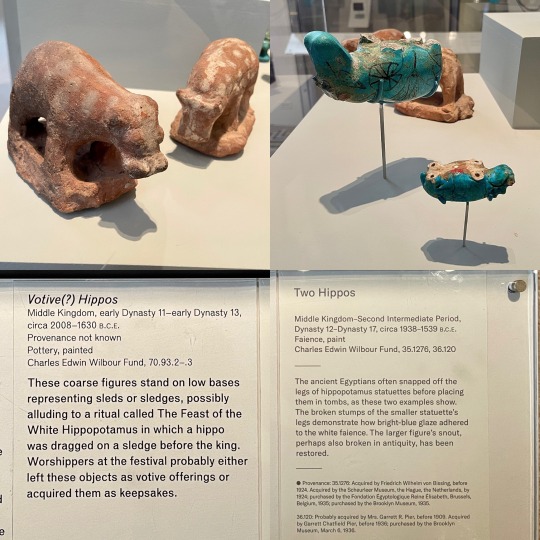
L: Votive(?) Hippos
Middle Kingdom Dyn.11-13 c2008-1630BCE
Painted pottery
“These coarse figures stand on low bases representing sleds or sledges, possibly alluding to a ritual called The Feast of the White Hippo in which a hippo was dragged on a sledge before the king. Worshippers at the festival probably either left these objects as votive offerings or acquired them as keepsakes.”
R: Two Hippos
Middle Kingdom Dyn.12-17 c1938-1539BCE
“The ancient Egyptians often snapped off the legs of hippopotamus statuettes before placing them in tombs, as these two examples show. The broken stumps of the smaller statuette's legs demonstrate how bright-blue glaze adhered to the white faience. The larger figure's snout, perhaps also broken in antiquity, has been restored.”
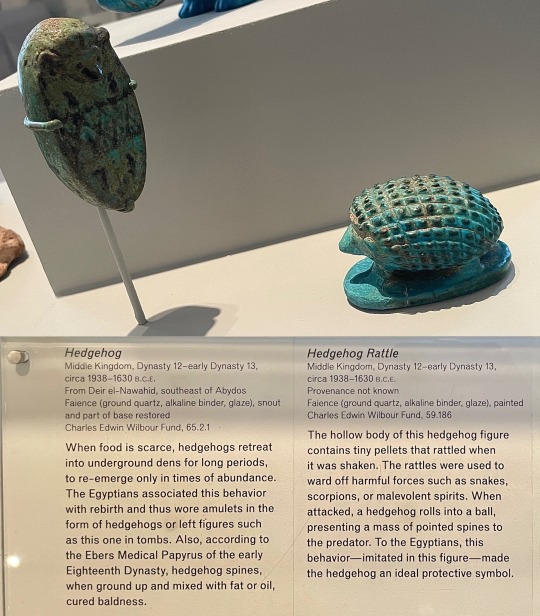
L. Hedgehog Rattle
Middle Kingdom Dyn. 12-13 c1938-1630BCE
Faience, 7.6 x 4.4 x 3.5 cm
“The hollow body of this hedgehog figure contains tiny pellets that rattled when it was shaken. The rattles were used to ward off harmful forces such as snakes, scorpions, or malevolent spirits. When attacked, a hedgehog rolls into a ball, presenting a mass of pointed spines to the predator. To the Egyptians, this behavior-_imitated in this figure-made the hedgehog an ideal protective symbol.”
R. Hedgehog Figurine
Middle Kingdom Dyn. 12-13 c1938-1630BCE
Faience, 4.2 x 4.1 x 7.1 cm
“When food is scarce, hedgehogs retreat into underground dens for long periods, to re-emerge only in times of abundance.
The Egyptians associated this behavior with rebirth and thus wore amulets in the form of hedgehogs or left figures such as this one in tombs. Also, according to the Ebers Medical Papyrus of the early Eighteenth Dynasty, hedgehog spines, when ground up and mixed with fat or oil, cured baldness.”
(note: labels are reversed - rattle is on L & figurine on R)
#animals in art#ancient art#Egyptian art#Ancient Egyptian art#Ancient Egypt#Brooklyn Museum#museum visit#hippo#hippos#hippopotamus#hippopotamuses#hedgehog#hedgehogs#pair#ceramics#pottery#faience#funerary art#votive#figurine#rattle
120 notes
·
View notes
Text
medical history protip: if an article claims that the Ebers papyrus "contains evidence of [whatever medical treatment the article is about]", don't take it at face value because a solid 50% of the time, if not more, it's bull.
#this is how you get stuff like ''the ancient egyptians definitely had abortions!!''#like fuck off they are unlikely to have practiced abortion based on the evidence ''cited''#this post brought to you by me trying to track down alleged mentions of cupping in ebers#which is cited on literally every fucking website about cupping but do they mention the column#or even more than a single line of the alleged remedy? like fuck
182 notes
·
View notes
Photo

Day 35 — Opium Poppy (unfurling)
The Mediterranean region contains the earliest archeological evidence of human use; the oldest known seeds date back to more than 5000 BC in the Neolithic age with purposes such as food, anaesthetics, and ritual.
Evidence from ancient Greece indicates that opium was consumed in several ways, including inhalation of vapors, suppositories, medical poultices, and as a combination with hemlock for suicide.
Opium is mentioned in the most important medical texts of the ancient and medieval world, including the Ebers Papyrus and the writings of Dioscorides, Galen, and Avicenna.
56 notes
·
View notes
Text
"Wild lettuce (Lactuca virosa) is a very common Solanaceae, from whose dried leaves and the decoction of its stems a hypnotic is obtained, the effect of which is proportional to the amount of vegetable reduced. It was known to the Assyrians, and among the ancient Egyptians it was a plant sacred to the god Min, the fertility god, and to the god Set in an erotic context in which he ends up pregnant after having eaten lettuce on which the semen of his rival, Horus, has been spilled (Manniche, 1989: 113). As a medicinal remedy, it appears in various formulas, for example, to relieve coughs or to remedy ear purulences, as recorded in the Ebers Papyrus (40, 64, 80, 312, 467). Dioscorides notes in this regard that its virtue is analogous to that of the opium poppy, as it relieves pain and makes one sleepy, which is why it was often mixed with meconium:
Drinking the seed of lettuce, it is useful to those who continually dream very lustful dreams, and restrains the venereal appetites.
Dried latex, also called lactucarium or lettuce opium, produces effects similar to opium, without any of the disadvantages of the latter (...) Theophrastus (Hist. pl., IX, 8, 2) refers to it as mekonion, a Greek name clearly alluding to opium, in a context in which it can only mean the Lactura virosa. In the Caucasus and Turkestan, Lactuca virosa is a plant of the dervishes, who consume its latex pure or mixed with hashish in order to have visions and enter into a trance".
Carlos C. Wagner, Las drogas sagradas en la Antigüedad.
#ethnobotany#drugs#solanaceae#drugs in antiquity#set#sutekh#min#horus#heru#set's lettuce isn't exactly lettuce#sacred plants
16 notes
·
View notes
Text
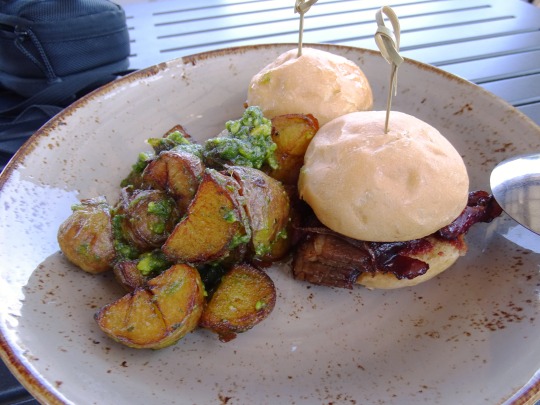

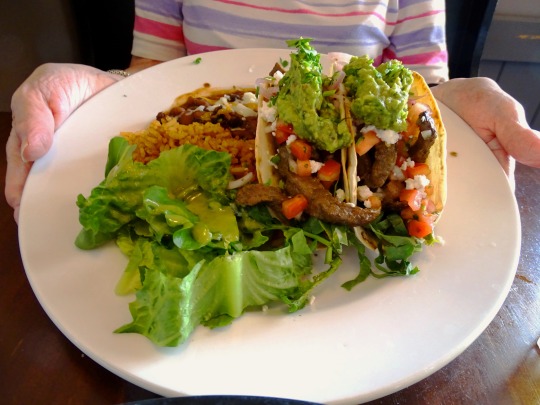

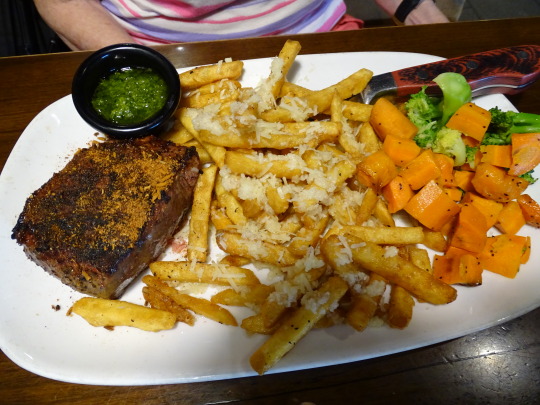

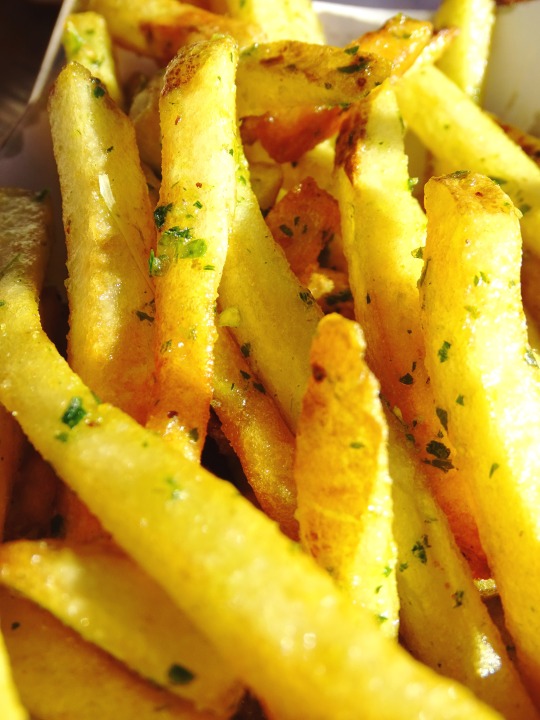
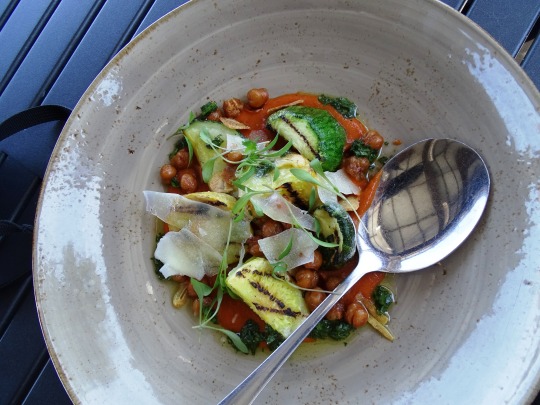


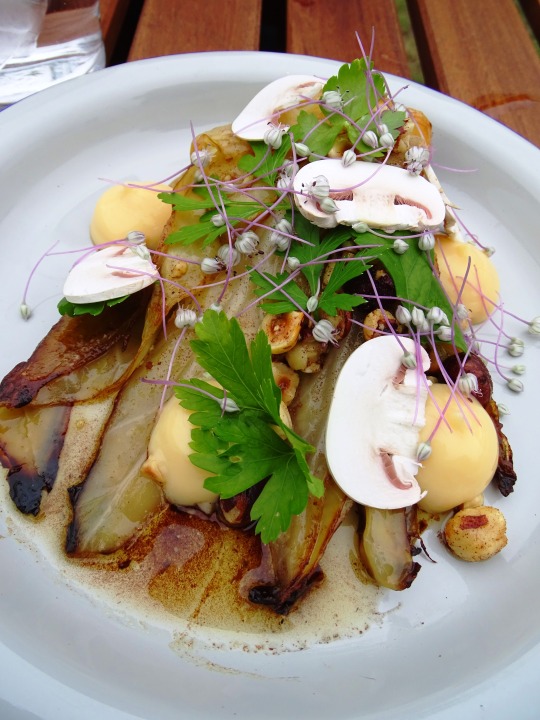

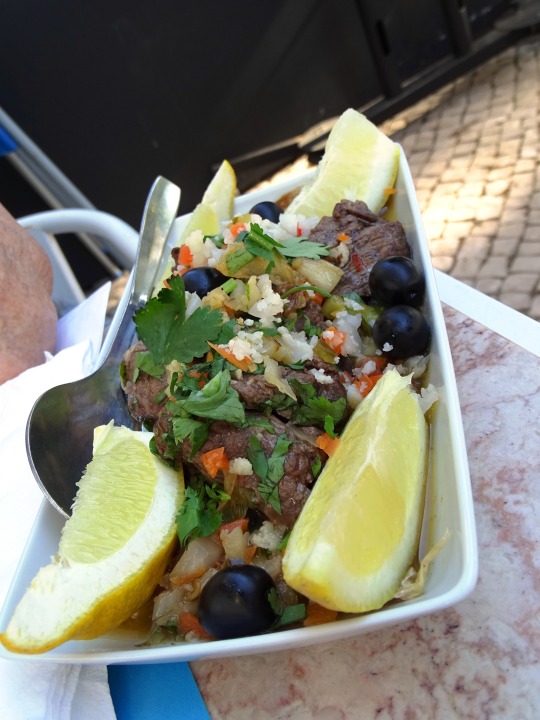

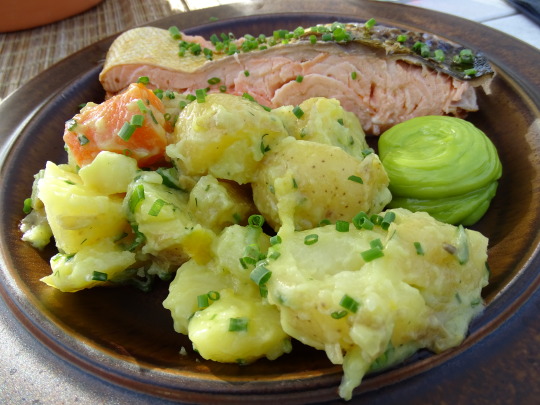


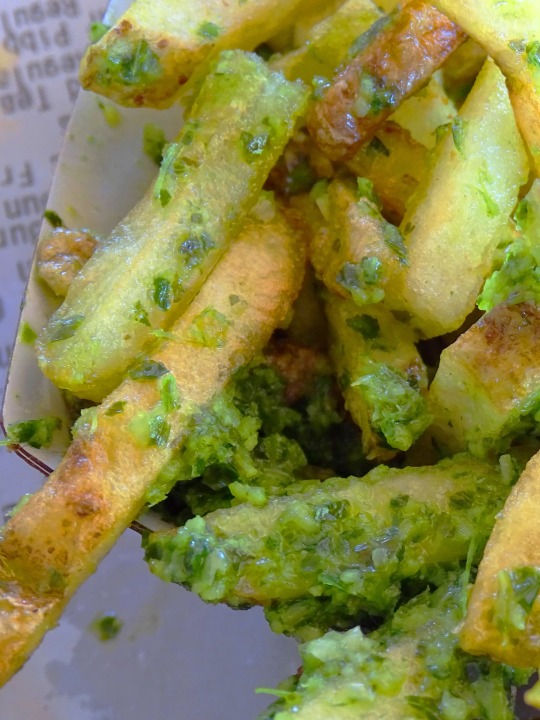

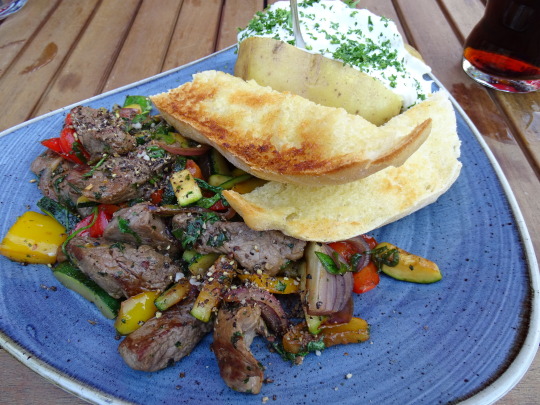






National Herb Day
It is National Herb Day on May 4! It is usually celebrated annually on the first Saturday of May. The HerbDay Coalition, an organization of five non-profit groups, started National Herb Day to raise awareness about the useful properties and importance of herbs in daily life. They also work towards encouraging people to learn more about the herbs and provide a better understanding of the extensive uses of herbs in daily life. Herbs are extensively used in food, medicines, and cosmetics. They also served as the first medicines ever used by humans to cure various ailments.
History of National Herb Day
Botanically, herbs are classified as the green parts of a plant used in food or medicine. Herbs are as old as human civilizations and have been used for cooking and medicine since time immemorial. There is well-preserved archaeological evidence pointing to the use of herbs 60,000 years ago. Neanderthals, ancestors of modern Homo sapiens, started using herbs for healing. In a way, we can say that herbs predate even that of recorded history and form the origin of much of modern medicine. Archeologists have discovered traces of pollen and other plant materials near burials, indicating the use of herbs.
There is hardly any civilization that didn’t take advantage of the use of herbs. The Sumerians, Egyptians, Indians, and Chinese all used herbs independently of one another. They created clay tablets that date back 5,000 years and listed hundreds of medicinal plants on them. In Egypt, texts like Papyrus Ebers describe ailments, treatments, and around 850 medicinal plants. The Indian medicinal school of Ayurveda, which uses natural remedies and herbal medicine to cure health conditions, is still prevalent in this modern age. Ayurvedic medicine has used many herbs dating back to 4000 B.C.
The study and use of herbs thrived in the Middle Ages when most cultures attributed spiritual qualities to herbs. A prominent example is the holy status of basil leaves in India. There is also a resurgence in the use of herbs in the last 40 years due to the impact of chemical drugs and the investment in pharmaceutical research and development. To address the growing popularity of herbs and to spread their importance, the HerbDay Coalition started National Herb Day.
National Herb Day timeline
6,000 Years Ago
The Rise of Ayurveda
The “Rig Veda” and the “Atharva Veda,” the Vedic scriptures of Hinduism, mention the prevalence of medicinal plants and Ayurveda.
5,000 Years Ago
Sumerian Texts on Herbs
Sumerians write about hundreds of medicinal herbs on clay tablets.
1526 A.D.
The First English Herbal
Peter Treveris prints “Grete Herball,” the first English herbal.
1600 — 1700
The Era of Bubonic Plague
The popularity of herbal medicines declines because of their ineffectiveness against the Bubonic Plague.
National Herb Day FAQs
How many herbs are there in the United States?
There are approximately 75 to 100 herbs listed in the National Library of Medicine
What is the most popular herb in the world?
Cumin is generally considered the most popular herb in the world.
Is an herb a vegetable?
Herbs are a subset of vegetables, which are generally composed of flavorful leaves of plants such as cilantro and basil.
National Herb Day Activities
Buy herbal products: Herbal products are rich in medicinal properties and nutrient values. Purchase herbal products for your daily use.
Invite friends for an herbal-themed party: Invite friends for an herbal-themed party. Create food and decorations in the shape of various herbs available in your locality.
Create an herbal garden: Create an herbal garden in your backyard. Try herbs that are already available in your locality before expanding your horizons over time.
5 Facts About Herbs That You Should Know
Stronger flavor for dried herbs: Both dried and fresh herbs can be used, but dried herbs have a stronger flavor.
Herbalists and botanists: In the middle ages, botanists were known as herbalists.
Herbal: The book of plants: A book containing the names, legends, stories, and descriptions of plants is called a ‘herbal.’
Herbal medicine users: 80% of people worldwide use herbal medicines.
Herbal medicines in Germany: Around 600 to 700 plant-based medicines are available in Germany.
Why We Love National Herb Day
Low side effects: Herbal medicines have fewer side effects compared to modern medications. It may be slow compared to modern medicine, but certain herbal medicines are effective against many lifestyle diseases.
Good for health: Herbs are good for your health. They are rich in nutrients and have medicinal value.
A second option: Herbal medicines are a second option for various lifestyle diseases. Major diseases like diabetes can be controlled with herbal remedies.
Source
#National Herb Day#4 May 2024#NationalHerbDay#first Saturday in May#salmon with potato salad#bratwurst#cabbage#Steakpfanne#Sweden#Germany#food#restaurant#original photography#Truffle Fries with parmesan reggiano#Garlic Fries#USA#roasted potatoes#mushroom#Madeleine#loaded baked potato#travel#vacation#Filet Port#scallops#Cataplana de marisco
2 notes
·
View notes
Text
omg, so I'm reading Wilson 1994 History of Mineral Collecting and 1) this is GORGEOUS. Oh my god, medieval paintings of mining and alchemy practicioners delight me and there's a GORGEOUS Victorian oil painting of a sample box with wulfenite and malachite and it's just- *chef's kiss*
But one of our earliest recorded examples of pharmaceutical mineral collection is a Mesopotamian pharmaceutical compendium from 2100BC (or more colloquially, 400 years before Ea Nasir), and has information on 120 minerals of medicinal value. There's also the Ebers papyrus from 1500 BC Egypt with more prescriptions from aluminum, copper, and halite.
#Isn't that FANTASTIC?!#UGH. I love that humans have loved minerals and used them for so long. ALSO we have a reference to my al-Jami/al Razi white whale#Have I mentioned my al Razi white whale?? he was an arabic doctor but knew metallurgy but nobody has written about it.#it's fucking infuriating and I might learn arabic
4 notes
·
View notes
Text

sometimes when i’m down i like looking at the ebers papyrus medical remedies. like fuck dude i guess
6 notes
·
View notes
Photo

Traitements Médicaux en Ancienne Égypte
Les Égyptiens de l'Antiquité connaissaient le même éventail de maladies que les gens d'aujourd'hui, mais contrairement à la plupart des gens de l'ère moderne, ils attribuaient cette expérience à des causes surnaturelles. Le rhume, par exemple, était très répandu, mais les symptômes n'étaient pas traités par des médicaments et du repos au lit, ou pas seulement, mais par des formules magiques et des incantations. Le papyrus Ebers (daté d'environ 1550 av. J.-C.), le texte médical le plus long et le plus complet qui nous soit parvenu, exprime clairement la vision égyptienne du traitement médical: "La magie est efficace avec la médecine. La médecine est efficace avec la magie". La magie dont il est question prend la forme de sorts, d'incantations et de rituels, qui font appel à des puissances surnaturelles supérieures pour guérir le patient ou traiter ses symptômes.
Lire la suite...
3 notes
·
View notes
Video
youtube
The Cupping Therapy
Cupping therapy is an alternative medical sort of practice and it has truly flooded in the new past because it is profoundly used by athletes and superstars also. Cupping therapy can be used for treatments and famous athletes have been known to use something very similar for their throbbing muscles. A great many people who have gotten an opportunity to give the therapy a shot appear to concur that it truly gives results at the day's end. Numerous superstars really display the injuries they get from cupping, to show the world that they are likewise making it happen.
There are lots of advantages that are associated with cupping and there are different methods that can be applied to arrive at the shared objective. The cups used in the process can be made using different materials. Different ointments can be used on the skin and furthermore, different cupping techniques can be applied in order to accomplish the objectives that are set.
Where it started
Any individual who has caught wind of the cupping therapy may really think something has just begun as of late. However, this isn't accurate. This is definitely not a recent fad. As a matter of fact, cupping therapy is exceptionally ancient and an astounding alternative medicine choice. A practice has been completed in Russia and china doe quite a while.
The therapy is additionally legitimate in the Ebers papyrus. These are records of the most established medical texts that are accessible today. This method was used by Hippocrates and Egyptians. The methods have been known in all pieces of Europe and Asia also.
This cupping therapy has been embraced by such countless societies on the planet. Their point was different. There are those that needed to manage different sorts of inside infirmities while others attempted to address a wide range of structural misalignment.
12 notes
·
View notes
Text
🌿🌸 Unlocking the Ancient Secrets of Skincare: The Medicinal Origins of Cosmetics 🌸🌿
👉 Discover the captivating history of skincare that dates back 5,000 years to ancient Egypt! 👈

🌟 Did you know that the very first cosmetics were used by the Egyptians to achieve a pleasant scent and soft skin? Incense oils and crushed flowers were just the beginning of a remarkable journey that would merge beauty with medicine. 🌺💆♀️
👩🔬 Step into the world of the ancient Greeks, who not only introduced the term "cosmetics" but also combined their knowledge of herbs and oils to create beauty concoctions with medicinal effects. Their expertise paved the way for what we know as modern cosmetics today. 💡💄
🌱 But wait, there's more to cosmetics than just looking good! Discover the fascinating revelation that cosmetics in ancient times were designed not only to enhance beauty but also to promote skin and body health. 🌟💖
🔍 Let's take a closer look at some incredible examples. The iconic Egyptian eyeliner not only made eyes pop but also shielded them from harmful sunlight and germs! 🌞💫 And did you know that Indian kajal liner was crafted from antibacterial herbs like neem and triphala? 🍃🌿 Beauty with a healthful twist!
🌸 In Japan, a lipstick called Benizara was made from safflower and rumored to have amazing benefits – from preventing gynecological issues to boosting blood circulation! 🇯🇵💄
📚 The wisdom of ancient civilizations lives on through herbal remedies found in the "Ebers Papyrus" (Egypt), "Botany" (Greece), "Ayurveda" (India), "Shennong" (China), and "Ishinpo" (Japan). 🌏💚 Embrace this timeless knowledge that connects us to nature and our past.
🌿🌹 Organic cosmetics harness the incredible power of botanical extracts, using innovative techniques to preserve the perfect balance of nature's wonders. No wonder they have amazing antioxidant and age-preventing effects! 🌿🍃
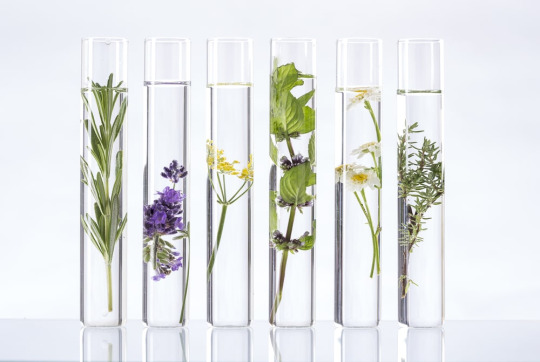
💧 Let's talk about some superstar plants used in organic cosmetics. Rosemary, known for revitalizing the skin and fighting aging, while Chamomile soothes, hydrates, and combats pesky spots and freckles. And lavender? It's a multitasker with its anti-inflammatory, antibacterial, and skin-revitalizing properties. 🌹🌼🌱
🌹 Gallica red roses, the beauty all-rounder, moisturize, firm, improve blood circulation, and enhance skin tone. And there's birch sap, an amazing ingredient that eliminates spots, dullness, fatigue, and stress while promoting skin renewal. 🌹💧
🌎 Organic cosmetics celebrate the complexity of nature – containing countless beneficial components in perfect harmony. Unlike synthetic ingredients, which can have singular effects, these botanical wonders deliver a plethora of goodness! 🌺🌿
🍃 So let's appreciate the magic of nature, as even the most advanced modern science can't replicate a single leaf from a plant. 🍂🌱 Embrace the importance of organic cosmetics, rooted in ancient wisdom and abundant in natural plant ingredients. Together, let's achieve healthy, radiant skin the way nature intended! 🌿💖
📖 Dive into the full article: [Link to the Article] 📖
#SkincareHistory#AncientCosmetics#OrganicBeauty#NaturalWonders#AncientWisdom#BeautyAndHealth#NatureKnowsBest#HealthySkin#RadiantComplexion#OrganicCosmetics#DiscoverSkincare
2 notes
·
View notes
Text
Hair Regrowth for Men Naturally
Hair Regrowth for Men Naturally
It usually happens that a father starts losing his hair in his 20s and now his siblings start feeling the same way around that time. If this sounds familiar, don't panic. Modern medicine and ancient wisdom can combine to create effective hair growth treatments that restore your youth with an attractive new profile.
History:

Hair regrowth treatments are not just a matter of fashion: Hair loss is not a new problem for mankind. At the beginning of 1553 B.C. AD, the oldest medical text called Papyrus Ebers contained a remedy for hair loss.Imagine a mixture of onions, honey, iron oxide, alabaster, white lead, and fat from lions, snakes, and other animals. The cure was to drink it after reciting a verse to the gods. After this first attempt, the father of modern medicine, Hippocrates, created another compound to be applied directly to the scalp. The Roman Emperor Julius Caesar also took care of his hair and used a comb to cover his bald head. There is no doubt that men, regardless of age, want to keep their hair and there are many modern ways to do it.
Today's medicine and the latest discoveries: beauty industry have finally understood the ancient remedies and transformed them into regrowth treatments. Today we deal with hair loss in a completely different way. We no longer need scripture or prayer for our healing to work. We now know exactly what hair is, what it takes to make it stronger,and why members of the same family suffer from hair loss. Thanks to this knowledge, new vitamin preparations become available, and keratin becomes one of the most valuable tools for hairdressers and image consultants. True Science. Real therapies. Real Results The human body is covered with hair follicles, and most of them form hair fibers so small that no one can see them. But some areas produce thicker hair, and it's particularly abundant in the scalp. Hair fibers are complex and made up of multiple layers of cells and proteins.One of these layers is called the cortex and contains abundant bundles of keratin that add shine and strength to each strand. Because of this, keratin products are used to make hair strong and shiny. One of these is Ultrax Labs Hair Rush DHT Blocking Hair Loss Maxx Hair Growth Nutrient Solubilized Keratin Supplement, which On the other hand, the hair follicle is responsible for hair growth. It contains the hair bulb and the cells that together make up the hair fiber. Various nutrients are required for hair follicles to function properly. However, it can be influenced by many different things, two of which are genetics and hormones. These cases can be complicated to treat, but modern medicine can solve this problem by controlling the action of testosterone in the hair follicles.Such treatment is usually expensive and requires specialist follow-up care. However, most people would agree that initial treatment should be natural. What if you start spending too much money on medication and everything you need is easier to find in groceries.
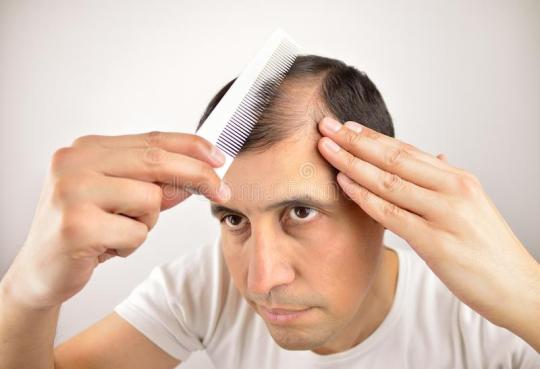
Therefore, combining a healthy diet with supplements may be just what you need to treat hair regrowth naturally. But before starting any of these treatments, it's a good idea to check with your doctor to make sure you're getting the right amount for your needs.What nutrients do you need to look out for to have healthy, thick and shiny hair Essential Hair Vitamins and Supplements Hair follicles are made up of many different cells and are complex in structure and function. However, studies have shown that many vitamins may be primarily involved in hair growth. Biotin, a water-soluble B vitamin, gives your hair extra strength. Sometimes the dander blocks the hair follicles and stops hair growth.Products with biotin can protect the scalp from dandruff and promote hair growth. Folic acid is also part of the vitamin B complex and helps the body make proteins.
Since your hair is full of it, it makes sense that a folic acid deficiency could lead to hair growth problems and an unhealthy grayish color. Certainly not attractive. Vitamin C is also important for hair growth.Hair follicles can get dented around them, making the hair look like corkscrews that break easily. Vitamin C is an important immune system booster and antioxidant that reduces damage to the skin and hair follicles. More damage, more broken hair. No wonder malnourished people tend to have dull and easily brittle hair. If you want a great hairstyle, remember that diet is your first ally.And supplements are always available to give you an extra boost when nutritious foods aren't readily available. What is the best natural way to regrow hair in men?also contains researched vitamins, minerals, and herbs formulated to help maintain healthy hair
Another powerful antioxidant is vitamin E. Same as vitamin C; helps fight free radical damage. Antioxidant vitamins are essential for treating hair growth. People with hair loss tend to have lower levels of antioxidants in the scalp. This causes more oxidative damage to the skin, which later blocks hair growth.Again, reducing damage to the skin and hair follicles would allow for the growth of new healthy hair that is visible overnight. Finally, other vitamins such as vitamin D and vitamin A are associated with healthy hair. A deficiency in these two nutrients leads to hair loss and dry hair. A deficiency is not common, but should be considered in a few cases. For example, vitamin D may be needed in dietary supplements for people living in countries far from the Earth's equator.And vitamin A is generally deficient in many developing countries or in malabsorption. On the other hand, a mineral deficiency can be another cause of hair loss. Iron, zinc and iodine have been described as major factors in hair strength. Iron deficiency causes anemia, and many people with the condition also have poor hair condition. Many have found better results in treating regrowth when iron supplements and foods are added to the diet.Therefore, a good hair loss supplement should contain vitamins and minerals to provide a full range of effects. Zinc deficiency is also a known cause of hair loss. Many researchers believe that people with alopecia have difficulty using the available zinc in the body or have low levels of zinc in their blood. Increasing zinc levels in your diet or through supplements is a great way to prevent this from being a cause of hair loss. Finally, iodine is essential for hair growth as it is closely linked to the proper functioning of thyroid hormones.Thyroid problems are responsible for many cases of hair loss, and increasing your iodine levels with sea vegetables or supplements can also restore healthy hair. All of these vitamins and minerals can be found in many different products, but not all are formulated to prevent hair loss. Ultra Labs Hair Rush contains 20 vitamins, minerals and herbs that act as nutrients for hair follicles and hair growth. Taking into account the science behind hair growth and the root causes of hair loss, this product combines the most researched ingredients for a natural hair growth treatment..Herbs for Hair Growth: Science or Myth? Talking of herbs seems to take us back to the first documented treatment for hair loss, dating back to ancient times. However, scientific facts have transformed many old-fashioned remedies into effective therapies. Such is the case of gotu kola, a plant used in Ayurvedic medicine for thousands of years to treat hair loss and other ailments. Recent studies show that gotu kola increases hair density and length in rats, making it an excellent choice for supplementation.Other herbs such as nettle leaves are also used to treat hair growth, with many users reporting great success. Ultra Labs Hair Rush is a preparation that combines vitamins, minerals and herbs used in the treatment of baldness and hair loss. Drug-free, Hair Rush is an all-natural and safe product that can become your first line of treatment before trying more specialized and expensive options. With it, you no longer have to count the need for vitamins and minerals. Hair Rush also features the addition of solubilized keratin, which provides the building blocks for the proteins in hair. A lot of people say that bald men look masculine, but if they don't, don't give up on natural solutions just yet. You may feel frustrated combing your hair, you may notice your hair falling out this morning. But perhaps a natural hair growth treatment is the key to restoring a more youthful appearance.
Article source: www.anoos.com
2 notes
·
View notes